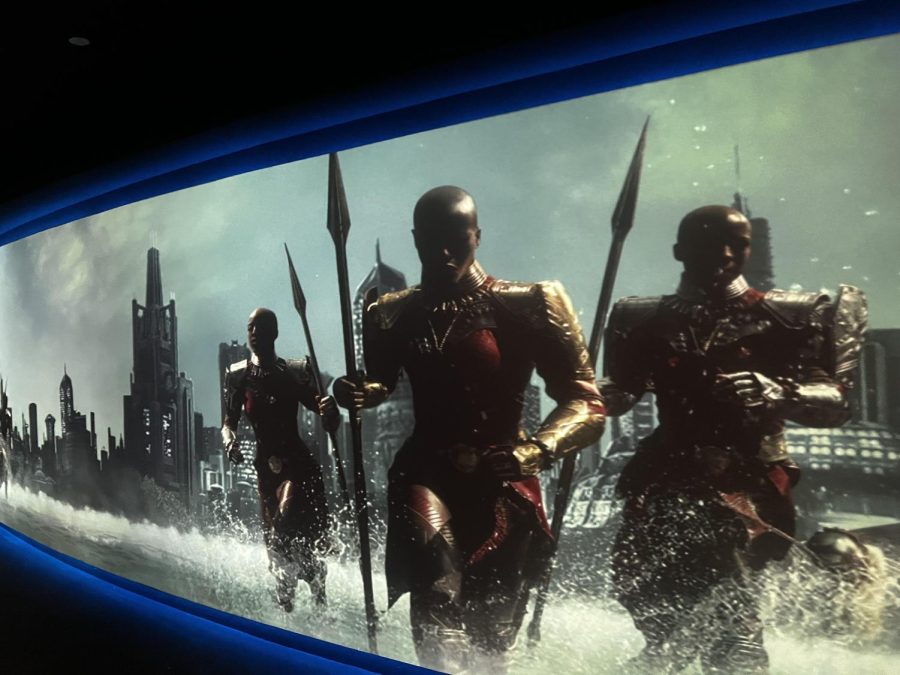‘Black Panther: Wakanda Forever’ tributes the late Chadwick Boseman
December 5, 2022
A story of internal conflict and reemergence, bureaucracy and personal agendas, was tragic yet uplifting while somehow incorporating comedic relief during times of strife. “Black Panther: Wakanda Forever” had incredible shoes to fill after Marvel fans and Hollywood lost Chadwick Boseman, who played King T’Challa in the Marvel franchise before losing a four-year battle with colon cancer in August 2020. Director and writer Ryan Coogler stared into a barrel of grieving family members and friends, co-stars and Marvel fans alike, with an almost impossible task of incorporating Boseman’s death in real life into his character’s death in the comics.
Prior to T’Challa’s death, the former King exposed Wakanda’s unlimited supply of Vibranium to the world, the rarest, most powerful metal alloy with indestructible qualities, making the country vulnerable to outside forces who want to utilize the metal for their own political advancements. As the film portrays, the world would cease to exist if the United States and other international counterparts had access to Vibranium as part of its military arsenal. The Queen of Wakanda, Ramonda (Angela Bassett), T’Chaka’s wife and mother to T’Challa and Shuri, makes it crystal clear that Wakanda remains unwilling to share Vibranium with the rest of the United Nations, not because of what Wakanda is capable of, but what others are if it fell in their hands.
Wakanda now faces conflict with the UN and a fatal war with their newest rivals from the sea, the Talokan, for primary possession of Vibranium. The Marvel Cinematic Universe (MCU) debuted the “Marvel Comics” original villain, Namor, played by Tenoch Huerta, who appeared in the first “Marvel Comics” issue in 1939 as the King of Atlantis. However, the MCU deviates itself from the world of Atlantis (presumably to avoid copyright infringement) and instead created a culturally multi-faceted Mayan Empire, rooted and beautifully portrayed by a Mesoamerican cast.
The only Talokan with ears pointed to the sky and wings at his ankles, Namor, “el niño sin amor” (“the boy without love”) leads the Talokan army into war with Wakanda; seemingly the first military force in the MCU capable of going against Wakanda’s extensive military technologies without a single weapon besides water bombs and the loyalty of sea creatures, including whales, dolphins and other insanely large aquatic mammals.
Due to the untimely death of the late Boseman, staying true to the comics made it that much more difficult, but that didn’t stop the MCU from bringing in the comic’s Ironheart, who first appeared in “Invincible Iron Man, Vol. 2 #7” in May 2016. In the film, Riri Williams, Ironheart’s everyday alter-ego, is a young Black engineering student and prodigy at MIT with the similar spunk and genius of Shuri, played by Letitia Wright, in which the two inevitably become one and the same.
“To be young, gifted and Black,” William says, which is arguably the epitome of the film’s entirety. Without giving away too many spoilers, the plot of “Wakanda Forever” would cease to exist if not for Williams’ class project that tracks traces of Vibranium, which was later dumped into the Atlantic Ocean and investigated by a team of professional scuba divers overseen by the Central Intelligence Agency (CIA).
While the “Invincible Iron Man, Vol. 2 #7” shows Iron Man approaching Williams after she reverse engineers the Iron Man suit into her own creation, fans are eager to see her new story unfold in the “Ironheart” television series to be released on Disney+ in late 2023; one where Iron Man is dead post-“Endgame” and the aftermath of her involvement in the war between the Talokan and Wakanda.
The end of the “Wakanda Forever” trailer gave away what fans already speculated; the identity of the next Blank Panther. With a deep passion and understanding of science and engineering, viewers witness Shuri experience internal turmoil between her intellect and her country’s spiritual practices, including the ancestral plane previous Kings reached after ingesting the heart-shaped herb. While at first Shuri does not believe in such an ancestral plane, she eventually comes to appreciate her spiritual identity when the appropriate ancestor comes to her in her most vulnerable time of need.
The score, under the purview of composer Ludwig Göransson, was impressive and culturally appropriate, given the cast was predominantly composed of POC. With a combination of American, Spanish and French pop music, compliments of crescendo bases and fortepiano techno beats were incorporated into scenes and provoked an emotional response from the audience, especially where the Mesoamerican Talokan were the focal point. Not to mention, after Rihanna announced her Super Bowl LVII performance, MCU and Rihanna fans were excited to hear her new single “Lift Me Up” featured as the credits rolled.
Despite previous criticism for lackluster computer-generated imagery (CGI) in the latest released MCU films, including the fight scene between Erik Killmonger and T’Challa in the original “Black Panther,” “Thor: Love and Thunder” and television series “She-Hulk: Attorney at Law,” the MCU has outdone themselves in “Wakanda Forever,” most notably the specific attention to detail in underwater scenes and the realism brought to the futuristic technology found in Shuri’s lab.
In the midst of all the politics, drama and action scenes, the driving force for Wakanda’s triumph is fueled by T’Challa’s death, so it only makes sense that “Black Panther: Wakanda Forever” is undoubtedly a tribute to Boseman’s legacy and dedication to the role of T’Challa. Contrary to popular belief, it seems as though MCU only made “Wakanda Forever” as an excuse to continue the Black Panther franchise and make some more money to fund their next extravagant blockbuster, but did so with immense respect and gratitude for Boseman by creating and releasing the film in his honor.
Nonetheless, fans can tell the film is one amongst many in a master plot for the next “Avengers: Endgame” and is definitely worth seeing. But if you haven’t already, prepare for more death to come, bring some tissues into the theater and as always, stay until after the credits roll for MCU’s notorious post-credits scene.
Rating: 7.5/10












